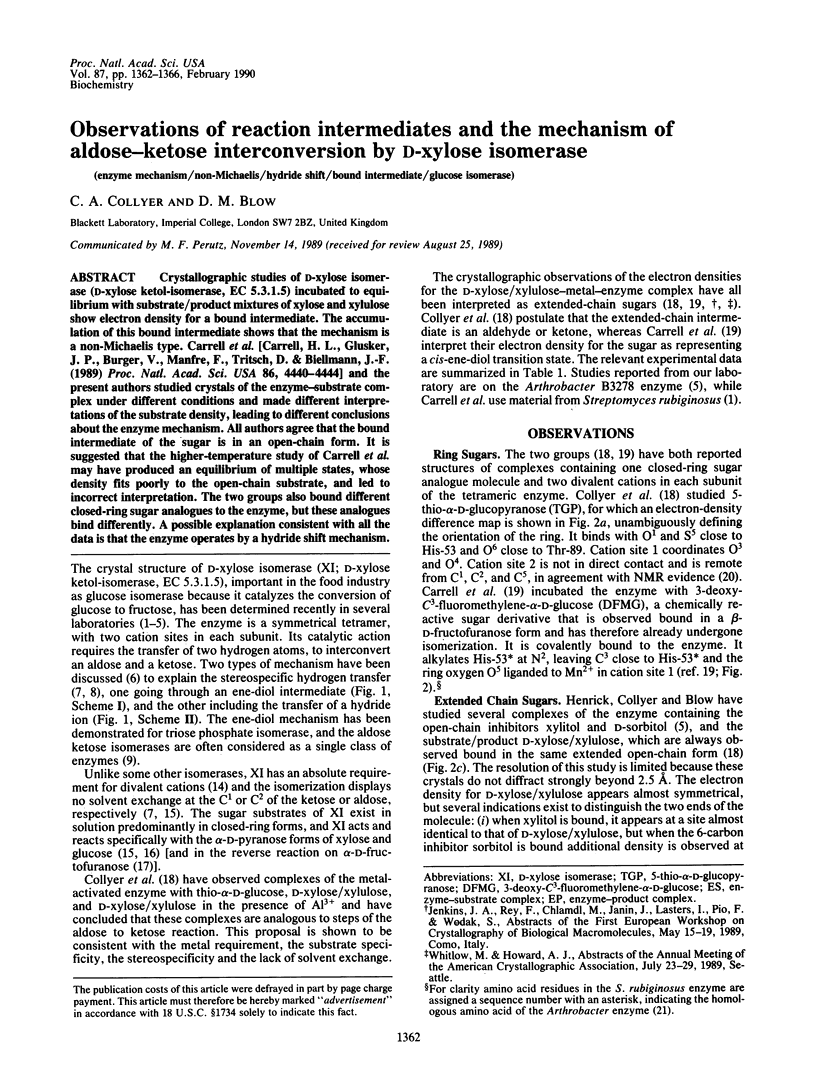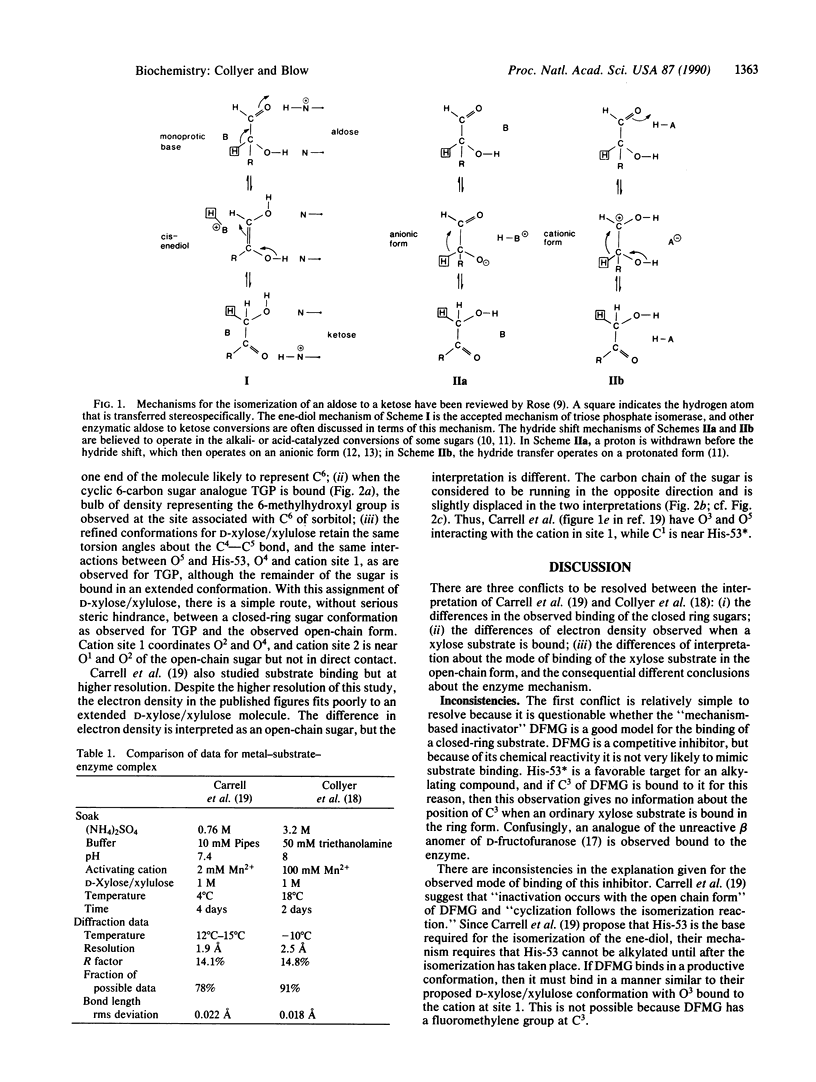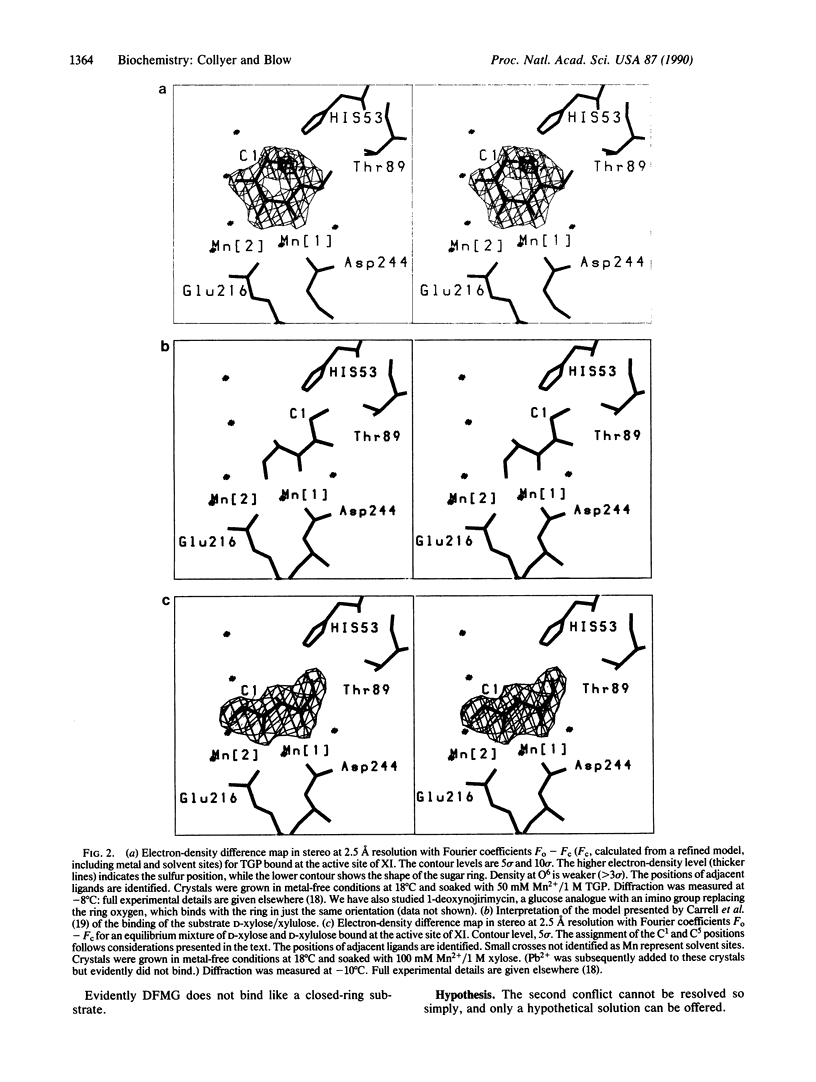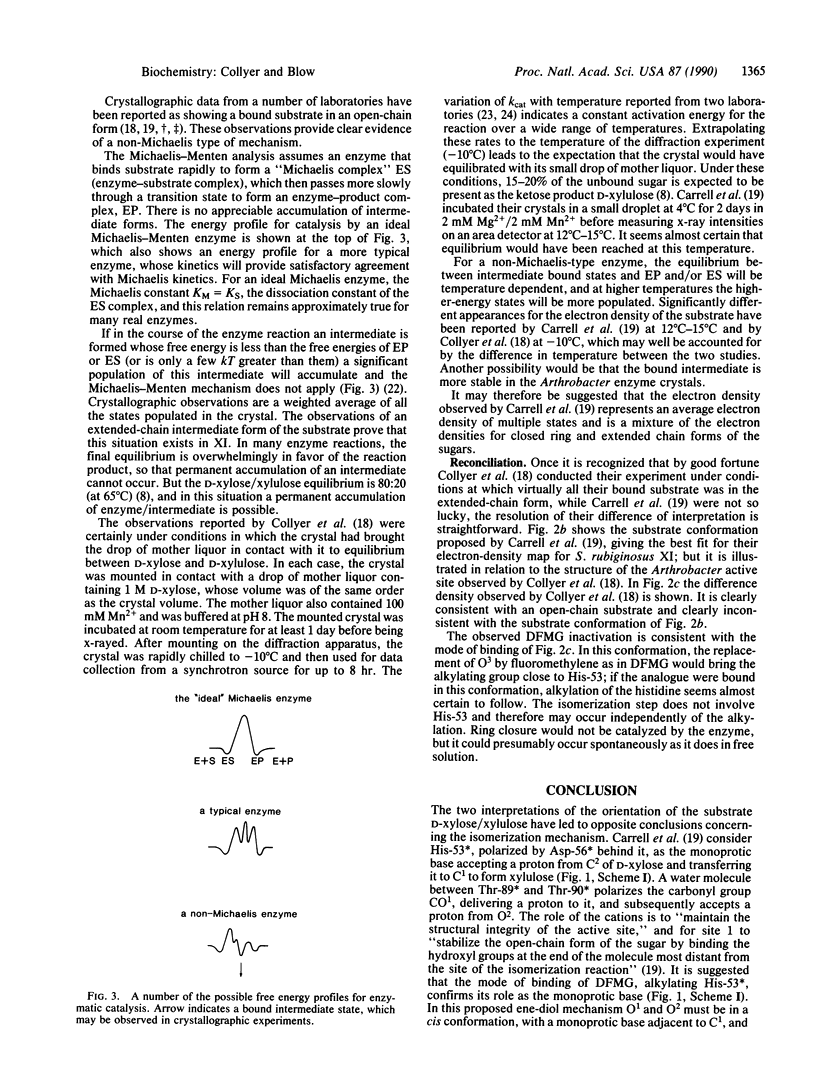Abstract
Crystallographic studies of D-xylose isomerase (D-xylose ketol-isomerase, EC 5.3.1.5) incubated to equilibrium with substrate/product mixtures of xylose and xylulose show electron density for a bound intermediate. The accumulation of this bound intermediate shows that the mechanism is a non-Michaelis type. Carrell et al. [Carrell, H. L., Glusker, J. P., Burger, V., Manfre, F., Tritsch, D. & Biellmann, J.-F. (1989) Proc. Natl. Acad. Sci. USA 86, 4440-4444] and the present authors studied crystals of the enzyme-substrate complex under different conditions and made different interpretations of the substrate density, leading to different conclusions about the enzyme mechanism. All authors agree that the bound intermediate of the sugar is in an open-chain form. It is suggested that the higher-temperature study of Carrell et al. may have produced an equilibrium of multiple states, whose density fits poorly to the open-chain substrate, and led to incorrect interpretation. The two groups also bound different closed-ring sugar analogues to the enzyme, but these analogues bind differently. A possible explanation consistent with all the data is that the enzyme operates by a hydride shift mechanism.
Full text
PDF




Images in this article
Selected References
These references are in PubMed. This may not be the complete list of references from this article.
- BARKER P. S. Systolic murmurs. J Mich State Med Soc. 1950 Dec;49(12):1440–passim. [PubMed] [Google Scholar]
- Bock K., Meldal M., Meyer B., Wiebe L. Isomerization of D-glucose with glucose-isomerase. A mechanistic study. Acta Chem Scand B. 1983;37(2):101–108. doi: 10.3891/acta.chem.scand.37b-0101. [DOI] [PubMed] [Google Scholar]
- Carrell H. L., Glusker J. P., Burger V., Manfre F., Tritsch D., Biellmann J. F. X-ray analysis of D-xylose isomerase at 1.9 A: native enzyme in complex with substrate and with a mechanism-designed inactivator. Proc Natl Acad Sci U S A. 1989 Jun;86(12):4440–4444. doi: 10.1073/pnas.86.12.4440. [DOI] [PMC free article] [PubMed] [Google Scholar]
- Carrell H. L., Rubin B. H., Hurley T. J., Glusker J. P. X-ray crystal structure of D-xylose isomerase at 4-A resolution. J Biol Chem. 1984 Mar 10;259(5):3230–3236. [PubMed] [Google Scholar]
- Dauter Z., Dauter M., Hemker J., Witzel H., Wilson K. S. Crystallisation and preliminary analysis of glucose isomerase from Streptomyces albus. FEBS Lett. 1989 Apr 10;247(1):1–8. doi: 10.1016/0014-5793(89)81227-x. [DOI] [PubMed] [Google Scholar]
- Farber G. K., Petsko G. A., Ringe D. The 3.0 A crystal structure of xylose isomerase from Streptomyces olivochromogenes. Protein Eng. 1987 Dec;1(6):459–466. doi: 10.1093/protein/1.6.459. [DOI] [PubMed] [Google Scholar]
- Feather M. S., Deshpande V., Lybyer M. J. Anomeric specificity during some isomerase reactions. Biochem Biophys Res Commun. 1970 Mar 12;38(5):859–863. doi: 10.1016/0006-291x(70)90799-0. [DOI] [PubMed] [Google Scholar]
- Henrick K., Blow D. M., Carrell H. L., Glusker J. P. Comparison of backbone structures of glucose isomerase from Streptomyces and Arthrobacter. Protein Eng. 1987 Dec;1(6):467–469. doi: 10.1093/protein/1.6.467. [DOI] [PubMed] [Google Scholar]
- Henrick K., Collyer C. A., Blow D. M. Structures of D-xylose isomerase from Arthrobacter strain B3728 containing the inhibitors xylitol and D-sorbitol at 2.5 A and 2.3 A resolution, respectively. J Mol Biol. 1989 Jul 5;208(1):129–157. doi: 10.1016/0022-2836(89)90092-2. [DOI] [PubMed] [Google Scholar]
- Rey F., Jenkins J., Janin J., Lasters I., Alard P., Claessens M., Matthyssens G., Wodak S. Structural analysis of the 2.8 A model of Xylose isomerase from Actinoplanes missouriensis. Proteins. 1988;4(3):165–172. doi: 10.1002/prot.340040303. [DOI] [PubMed] [Google Scholar]
- Rose I. A. Chemistry of proton abstraction by glycolytic enzymes (aldolase, isomerases and pyruvate kinase). Philos Trans R Soc Lond B Biol Sci. 1981 Jun 26;293(1063):131–143. doi: 10.1098/rstb.1981.0067. [DOI] [PubMed] [Google Scholar]
- Rose I. A., O'Connell E. L., Mortlock R. P. Stereochemical evidence for a cis-enediol intermediate in Mn-dependent aldose isomerases. Biochim Biophys Acta. 1969 Apr 22;178(2):376–379. doi: 10.1016/0005-2744(69)90405-7. [DOI] [PubMed] [Google Scholar]
- Schray K. J., Rose I. A. Anomeric specificity and mechanism of two pentose isomerases. Biochemistry. 1971 Mar 16;10(6):1058–1062. doi: 10.1021/bi00782a019. [DOI] [PubMed] [Google Scholar]
- TOPPER Y. J. On the mechanism of action of phosphoglucose isomerase and phosphomannose isomerase. J Biol Chem. 1957 Mar;225(1):419–425. [PubMed] [Google Scholar]
- Wimmer M. J., Rose I. A. Mechanisms of enzyme-catalyzed group transfer reactions. Annu Rev Biochem. 1978;47:1031–1078. doi: 10.1146/annurev.bi.47.070178.005123. [DOI] [PubMed] [Google Scholar]
- Young J. M., Schray K. J., Mildvan A. S. Proton magnetic relaxation studies of the interaction of D-xylose and xylitol with D-xylose isomerase. Characterization of metal-enzyme-substrate interactions. J Biol Chem. 1975 Dec 10;250(23):9021–9027. [PubMed] [Google Scholar]



